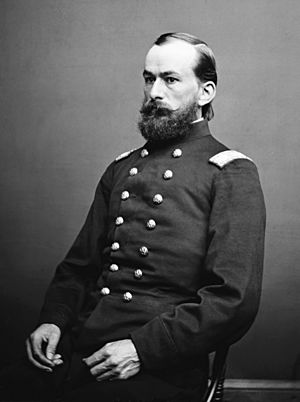Asa P. Blunt facts for kids
Quick facts for kids
Asa Peabody Blunt
|
|
|---|---|

As a Colonel in 1862
|
|
| Born | October 19, 1826 Danville, Vermont |
| Died | October 4, 1889 (aged 62) Manchester, New Hampshire |
| Place of burial |
Pine Grove Cemetery,
Manchester, New Hampshire |
| Allegiance | Union |
| Service/ |
United States Army Union Army |
| Years of service | 1861–1888 |
| Rank | |
| Unit | 3rd Vermont Infantry 6th Vermont Infantry 12th Vermont Infantry 2nd Vermont Brigade |
| Battles/wars | American Civil War *Battle at Lee's Mills *Battle of Savage's Station |
Asa Peabody Blunt (born October 19, 1826 – died October 4, 1889) was an important officer in the Union Army during the American Civil War. He continued to serve in the army even after the war ended. Because of his brave service, he was given the special rank of brevet brigadier general. This means he was honored with the rank, but did not always get the full pay or command of a regular brigadier general. Blunt was well-known for leading the 2nd Vermont Brigade. He also commanded the United States Disciplinary Barracks at Fort Leavenworth, Kansas.
Contents
Early Life and Work
Asa Peabody Blunt was born in Danville, Vermont. In 1850, he lived in Southampton, New York with his wife, Mary. He worked there as a manager in a cotton mill. By 1860, the Blunts had moved to St. Johnsbury, Vermont. Here, Asa worked as a draftsman for the Fairbanks Scales company. A draftsman draws detailed plans, like for machines or buildings.
Service in the Civil War
Blunt joined the army on June 6, 1861. He became an adjutant for the 3rd Vermont Infantry. An adjutant is an officer who helps with administrative tasks. On September 25, he was promoted to lieutenant colonel in the 6th Vermont Infantry.
Leading the 12th Vermont Infantry
On September 19, 1862, Blunt became a Colonel of the 12th Vermont Infantry. Soon after, on October 27, the 2nd Vermont Brigade was formed. This brigade was made up of five Vermont infantry regiments: the 12th, 13th, 14th, 15th, and 16th. Colonel Blunt took temporary command of this new brigade. He was the highest-ranking colonel there. He led the brigade until December 7, when Brigadier General Edwin H. Stoughton arrived to take over.
Temporary Command of the Brigade
General Stoughton was not very popular with his soldiers. So, when he was captured by Confederate forces on March 9, 1863, few people were sad to see him go. Colonel Blunt again took command of the brigade. He led them until April 20, when a new commander, Brigadier General George J. Stannard, arrived.
Gettysburg and Later Service
By June, most of the brigade was ready to go home. Their nine months of service were almost over. However, Robert E. Lee's army moved into Pennsylvania. This delayed their departure for a few weeks. The brigade finally saw some action. Blunt's 12th Regiment and the 15th Regiment stayed behind in Emmitsburg, Maryland. They were guarding important supply trains. Because of this, they could not join the brigade's famous move that helped stop Pickett's Charge at the Battle of Gettysburg on July 3.
On July 4, Blunt's regiment was allowed to return to Vermont. He left the army with his regiment on July 14, 1863.
Return to Service and Promotion
Blunt rejoined the army just over six months later. On February 24, 1864, he became a Captain and Assistant Quartermaster of Volunteers. A quartermaster is in charge of supplies and equipment. He worked in the Quartermaster's Department. On May 4, 1864, he became the main quartermaster for the Army of the James. He stayed in this role until late 1865.
For his excellent service at the Battle at Lee's Mills and Battle of Savage's Station, President Andrew Johnson honored Blunt. On May 4, 1866, he was nominated for the rank of brevet brigadier general. The United States Senate approved this on May 18, 1866. He also received other brevet ranks, including major, lieutenant colonel, and colonel.
After the War
After the war, Blunt continued his military career. On July 14, he moved to Fort Monroe. He stayed there until July 1866. In late August, he became the Chief of the Quartermaster Department of the Potomac.
On March 28, 1867, he received a permanent commission as Captain and Assistant Quartermaster. He also received brevet ranks of major and lieutenant colonel. He was put in charge of National Cemeteries in Virginia. On April 9, 1867, he officially left the volunteer service. Two days later, he became Chief Quartermaster for the First Military District in Richmond. Later, he moved to Washington, D.C. There, he managed Lincoln Depot and other National Cemeteries. By March 1, 1869, he was the Department Quartermaster in Charleston, South Carolina.
Between 1877 and 1888, Blunt was the leader of the United States Disciplinary Barracks. This was a military prison at Fort Leavenworth, Kansas.
Blunt was promoted to a permanent major on September 29, 1889. He passed away in Manchester, New Hampshire, on October 4, 1889. He was buried at Pine Grove Cemetery in Manchester.

